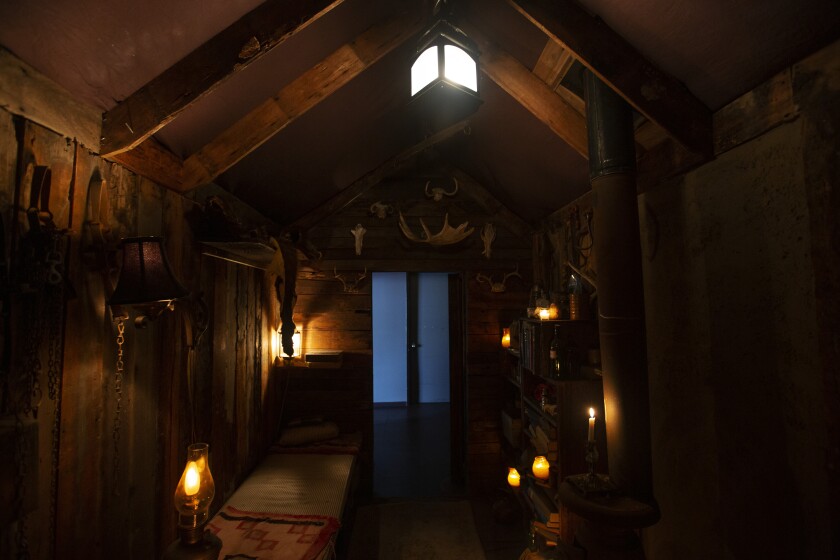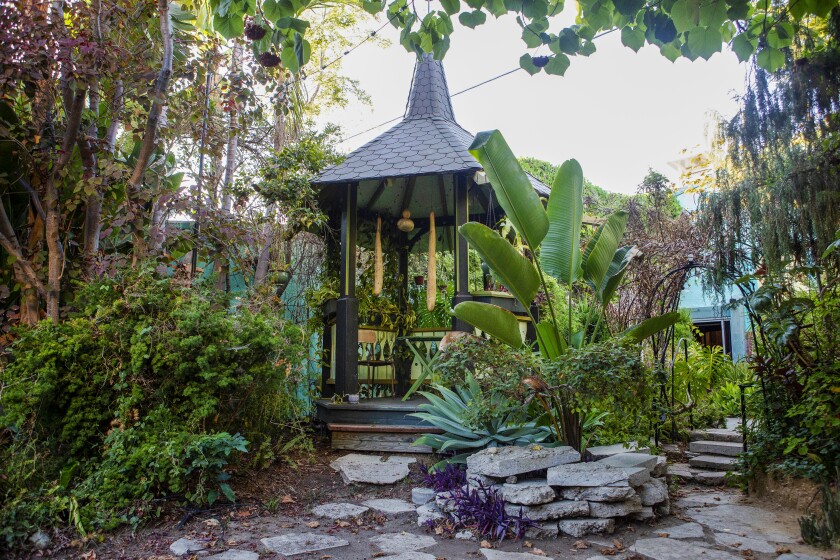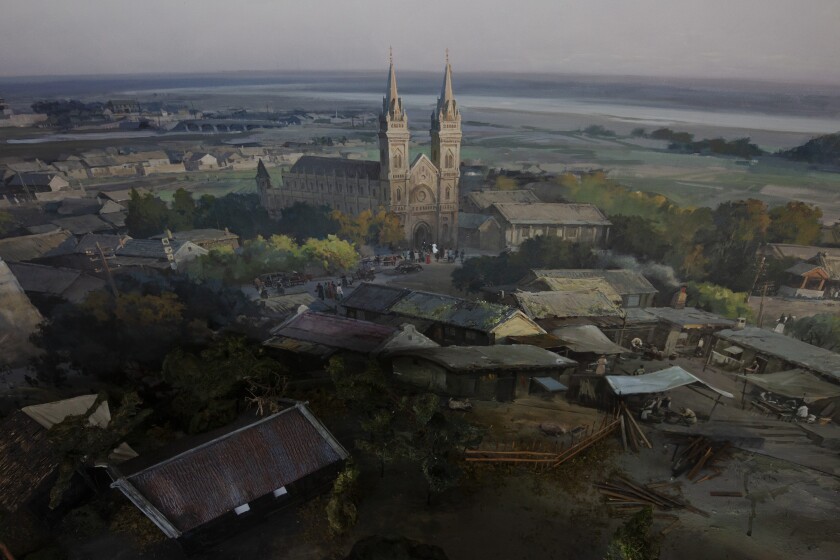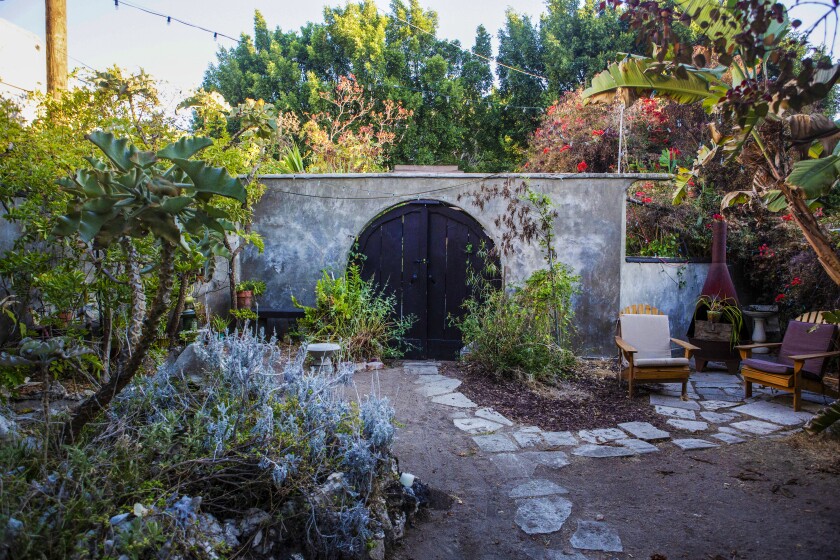On a modest residential street in L.A.’s University Park neighborhood sits an old silent movie theater painted an eye-popping shade of aquamarine.
The historic building has housed a storefront church, a drama school, and for four decades served as headquarters for the tile layers union, Local 18.
Today, it’s the home of the Velaslavasay Panorama — a strange and immersive, only-in-L.A. art experience that defies easy explanation.

Sara Velas inside the Velaslavasay Panorama.
(Madeleine Hordinski / Los Angeles Times)
“It doesn’t fit neatly into any boxes, and that was a huge part of the desire to create it,” said Sara Velas, 44, who launched the project 21 years ago.
Step into the theater’s mustard-colored lobby and you’ll find a ticket booth and a pint-size gift shop selling miniature Ouija boards as well as tote bags and visors. To the left, a short hallway leads to a life-size diorama of an Arctic trading post, complete with lanterns, a cot, a bear pelt and a picturesque window view.

The Nova Tuskhut — a life-size diorama of an Arctic trading post — at the Velaslavasay Panorama.
(Madeleine Hordinski / Los Angeles Times)
Toward the back of the building you’ll find the original theater, with the seats still intact. From there you emerge outdoors into a surreal tropical oasis filled with towering plants from around the world, a shell-encrusted water feature inspired by the mythological Isle of Penglai from Chinese folklore and the olive green Pavilion of the Verdant Dream, a gazebo modeled after garden scenes from traditional Chinese opera, currently adorned with enormous gourds.

The Velaslavasay Panorama garden.
(Madeleine Hordinski / Los Angeles Times)
On the top floor of the building is the panorama itself — an exquisitely detailed 360-degree painting depicting the bustling Chinese city of Shengjing in the early 20th century. (Today the city is called Shenyang.)
None of it makes any sense, except that somehow it does.

The overlook that introduces visitors to the immersive experience, and the panorama view.
(Madeleine Hordinski / Los Angeles Times)
The Velaslavasay Panorama has never drawn enormous crowds, and its social media following is mediocre at best (its Instagram page has fewer than 2,000 followers). But for a certain type of L.A. explorer, this makes it all the more appealing. Entering the strange, unexpected world that Velas and her collaborators have created is a welcome reminder that despite skyrocketing property values and a devastating pandemic, pockets of weird L.A. continue to persist against all odds.
Velas says the spirit of the panorama is most in alignment with other beloved and uniquely L.A. institutions, such as the Bob Baker Marionette Theater, the Watts Towers and the Museum of Jurassic Technology.
“It’s other creative folk art environments where things are built with an internal logic of their own, but it is hard to explain exactly what that logic really is,” she says.
The centerpiece of the Velaslavasay is the panorama itself — a kind of visual illusion popular in the Victorian era. Essentially, it’s a circular painting designed to transport the viewer to a different place and time.

A close-up view of a the Shengjing Panorama, depicting an urban Chinese landscape during the years 1910 to 1930: This painting illustrates an era of great technological change, global exchange and diversity in architecture, religions and culture.
(Madeleine Hordinski / Los Angeles Times)
“A circular panorama is more than just a painting,” Velas said. “It’s defined by a set of prescribed viewing conventions, and its painters know how to use composition and painting skills to create the illusion of depth.”
Like many such paintings, the Shengjing Panorama incorporates three-dimensional elements — street lamps that light up, a fortune-telling scene and a market complete with tiny vegetables — that make the painting feel as if it were spilling out beyond its boundaries.
For Velas, who studied painting in college and has done a few panoramas of her own, a huge part of the draw of the art form is what she calls “the magic trick component.”
“When you are standing in our panorama, you know you aren’t actually in northeast China 100 years ago, but you can feel this suspension of disbelief, and that is the magic trick at work,” she said.
The Shengjing Panorama has been on display since 2019, and it is the third circular painting to be featured at the Velaslavasay. The first was Panorama of the Valley of the Smokes, Velas’ rendering of what Southern California might have looked like 200 years ago. Next came Effulgence of the North, also painted by Velas; it took visitors to the icy, windswept North Pole, where the ethereal aurora borealis lighted up the night sky. On average, Velas said, it takes one to two years to complete a panorama painting 90 feet in circumference.
The current one was painted by a trio of celebrated panorama artists in China — Li Wu, Yan Yang and Zhou Fuxian, whom Velas met at a conference of the International Panorama Council in 2005. (China is one of four countries where the art form continues to flourish — the others are Turkey, North Korea and Russia). The collaboration represents the first time the three artists had their panorama work displayed outside China. Ruby Carlson, co-curator of the Velaslavasy, calls them rock stars of the panorama world.
The painting is accompanied by a 40-minute composition of recorded ambient sounds — trains rushing by, birds squawking overhead, the rush of water, church bells. Close your eyes and you feel like you are in the northeastern Chinese city. A lighting cycle allows visitors to enjoy the urban scene in the bright light of day, the muted gray tones of night and the orange hues of dawn.
*
Velas was born in Panorama City (no joke) and has always liked making things with her hands. She first learned about panorama painting as a student at Washington University in St. Louis as part of a research project on world fairs for a Victorian literature class.
Velas was drawn to the outdated art form immediately. Displaying her work in a white box gallery, in the hopes of being discovered, never appealed to her. The whole thing sounded boring and kind of lonely. Panoramas offered the promise of collaboration and spectacle.
“The experience of making it, especially in the 19th century, had to be a group activity, because they were so big,” she said. “It was very much like a cinema production. Maybe there was a lead architect or designer whose name got attached to it, but it was a team effort.”

Ruby Carlson, left, and Sara Velas inside the Velaslavasay Panorama.
(Madeleine Hordinski / Los Angeles Times)
She attempted her first panorama as a senior in college. It was boxy and awkward, painted on panels rather than in the round, but it still activated the viewer’s peripheral vision. And it taught her that this style of painting could feel like performance.
“It was pretty exciting,” she said.
Velas knew she wanted to keep working with the panorama form after graduating in 1999, but she wasn’t sure what that would look like.
“It’s not like I would have thought I could find a round building — that would have been too weird and presumptuous,” she said. “But then, there it was.”
In 2000, while driving on Hollywood Boulevard, Velas happened on the perfect venue for her art: A small, round building surrounded by towering palm trees just west of Western Avenue that was the former home of a Chinese Polynesian-themed restaurant. She quickly signed a lease and spent nine months adapting the space and working on her first installation — “Panorama of the Valley of the Smokes.” The Velaslavasay Panorama officially opened its doors in 2001.
Three years later, however, the building was slated for demolition. Julie Silliman, cultural arts planner for the Community Redevelopment Agency of the City of Los Angeles, helped Velas find a new space. The panorama has been there ever since.
Today, visits to the Velaslavasay Panorama are available by appointment from 11 a.m. to 4 p.m. Fridays and Saturdays. It costs $7 per person to reserve a spot. Carlson recommends visitors spend at least an hour at the theater to explore the Nova Tuskhut, fully take in the Shengjing Panorama and enjoy the garden.
“Come with someone you can have a long conversation with that has nothing to do with art,” she said.
*
The Velaslavasay Panorama is financially supported by a mix of grants, private donations and memberships; in non-pandemic times, many day-to-day expenses were paid for by private rentals for weddings, film shoots and screenings.
That critical funding dried up when the COVID-19 pandemic hit last year, and for a few months in 2020, Velas wasn’t sure whether she could continue to pay rent on the building. Fortunately, the Panorama received emergency support grants last year — one from the Getty Foundation and the California Community Foundation, and another that was related to CARES Act funding through L.A. County.
The panorama also continued to receive support from donors and other grant programs already in place, including from the Andy Warhol Foundation for the Visual Arts, the Opaline Fund and the L.A. County Department of Arts & Culture.

The Velaslavasay Panorama garden.
(Madeleine Hordinski / Los Angeles Times)
Although the building was closed to the public from March 2020 to June 2021, Velas, Carlson and their small crew of volunteers and work-study students remained hard at work. Some of their pandemic projects were boring but necessary, such as reconfiguring their membership database, others more creative.
In September 2020, they transformed the theater’s lobby into a living tableau called the Union Square Florist Shop as part of a series of art happenings around the city called “Maiden LA.”
Sometimes the scene inside the theater looked benign, other times more sinister.
“It was designed to be confusing,” Velas said.
A few months later, Velas and her collaborators published the Floral Syndicate Society Gazette, a small magazine with articles on such topics as mums, rotating architecture in Southern California and extraterrestrial interactions.
The publication’s motto reads: “If you are running away from crazy people you are running in the wrong direction.”
A second issue is coming soon.
“The whole project was very much a response to our pandemic lockdown conditions,” Velas said. “It would have been insane three years ago to design an event where nobody ever entered the building, but we had no choice.”
Events have always been central to the panorama’s mission. Velas and her collaborators have hosted seances, illustrated lectures, traditional musical performances, and when “Effulgence of the North” was on display, they created a short-lived Polar Film Club featuring movies about the Arctic and the Antarctic. This summer, the Velaslavasay hosted an outdoor Chinese film series in the garden to celebrate its 20th anniversary and the second anniversary of the Shengjing Panorama. All three films bore some relationship to the panorama.
Velas says she’ll likely keep the Shengjing Panorama up until at least 2023, in part to make up for the year people were not able to see it. She and Carlson are already working on more exhibits and printed materials inspired by the panorama, including a timetable to reinforce that visitors are about to journey from modern day L.A. to a Chinese city 100 years ago.
“It’s a multifaceted approach,” Velas said.
Experiencing the panorama for the first time can leave a visitor both mystified and elated — a kind of Alice in Wonderland feeling of curiouser and curiouser.
One wonders: Where am I? Who made this? How does this even exist?
Carlson, who started working with Velas in 2009, said she has a perverse sense of victory that this strange art project has been able to survive for 20 years in a city that often feels trapped in a cycle of destroying the old to make room for the new.
“We don’t make a ton of money, and we’re still here,” she said. “We’re preserving this theater. We’re not tearing it down. And we’re putting the neon back up.”
And that’s another way the Velaslavasay inspires: If it can continue to survive in this city, maybe we all can.
The Velaslavasay Panorama
Where: 1122 W. 24th St., Los Angeles
Hours: By appointments only, 11 a.m. to 4 p.m. Fridays and Saturdays
Cost: $7
Info: panoramaonview.org
Weird L.A.: Do you know of a place in Los Angeles that is weird and wonderful and deserves to be shared with the world? Email me at [email protected]
Stay connected with us on social media platform for instant update click here to join our Twitter, & Facebook
We are now on Telegram. Click here to join our channel (@TechiUpdate) and stay updated with the latest Technology headlines.
For all the latest Entertainment News Click Here
For the latest news and updates, follow us on Google News.
